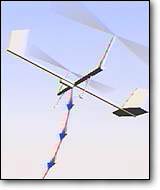 World wide wind potential (using only conventional wind technology) exceeds our current energy needs by many times. However, that is merely the potential of wind near the ground, at 80 to 100 meters.
World wide wind potential (using only conventional wind technology) exceeds our current energy needs by many times. However, that is merely the potential of wind near the ground, at 80 to 100 meters.
Most wind energy is in the jet stream, miles over our heads. No one is going to build a tower that high to support a wind turbine; cost alone would prohibit that. But we can use flying energy generators — turbines supported by kites or balloons or what amounts to stationary helicopters. The latter technology (stationary helicopters supporting wind turbines) has actually been demonstrated briefly, and has been claimed in peer reviewed research to be ready for commercial implementation (PDF). Questions like net energy, metal fatigue, stability, transformers and power loss have all been answered — at least on paper. (Net energy at really high altitudes is higher than with either kites or helium balloons — due to wasted energy on the downward part of the cycle with kite systems, and drag with balloon systems.)
According to the corporation developing this technology, Sky WindPower, they can put together a system out of commercially available products that will provide wind electricity (at a profit) for 2 cents per kWh — competitive with current fossil fuel generation.
Now of course, being ready on paper, even when combined with a very brief proof of concept demonstration, is not the same as being ready to deploy commercially. Quite sensibly they are seeking to put together a demonstration project, both to work out any bugs, and to demonstrate that the economics pan out in practice. (Naturally, a smaller than optimum project will produce more expensive power. The key here will be to deliver power at the predicted cost, then show that the same methodology and assumptions predict the 2 cent cost when scaled up.)
Normally I like to spend my time showing that already proven technology can solve our problems, that the obstacles to a sustainable society are political, not technical or even micro-economic. But this has such huge potential, hundreds of times current world energy (not just electricity) consumption and seems so close to being ready, that I really hope people will pay more attention to it.
The turbines to tap this energy are more expensive than ground level ones, but faster winds mean you get many times the peak energy from flying turbine than you could from a ground based one the same size, and you get close to that peak energy more often. In other words capacity is higher, and you tap more of that capacity besides. The steadier power means you have more reliable, higher quality power besides. In some areas, in some months you can get 90 percent capacity utilization without storage. More to the point, the amount of storage needed to turn Flying Energy Generators (FEGS) into sources of baseload quality electricity are much smaller than for ground based wind farms.
They are not without problems, of course. Putting up generators at this height means we have to ban aviation wherever they are installed. But to put the problem in perspective, if FEGS were to provide 100 percent of U.S. energy, we would have to ban airplanes from 1/400th of U.S. airspace. Aviation is already interdicted from that much of U.S. airspace for various reasons — including our failed “war on drugs.” This is a much more important purpose. We are going to have to reduce the number of flights worldwide anyway due to warming effects from water vapor and NxOx emitted at stratospheric levels. You could argue that discouraging air travel is a feature rather than a bug — except of course that the demands on airspace are too small to actually discourage any air travel.
I’m not saying at this point we should start pouring billions into the things. But a demonstration project somewhere where air traffic is already interdicted should be a priority for government funding. And hopefully, if such a project is funded, private investors will pay close attention to the results. I would add that if I were a venture capitalist interested in high risk/high return projects I would seriously consider funding such a demonstration in return for a substantial stake in the company — after, of course, doing very close analysis of both the technology and the company.
 World wide wind potential (using only conventional wind technology)
World wide wind potential (using only conventional wind technology) 
